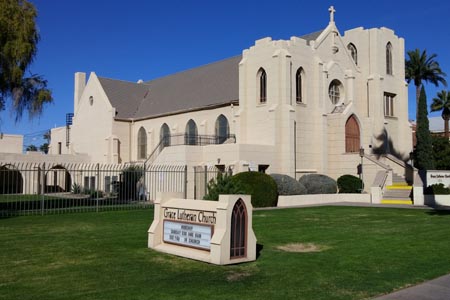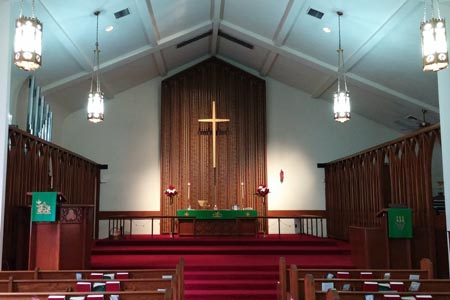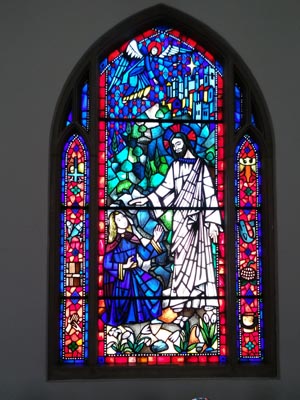| |
 |
 |
 |
| Comment on this report, or find other reports. |
 |
| Our Mystery Worshippers are volunteers who warm church pews for us around the world. If you'd like to become a Mystery Worshipper, start here. |
 |
| Find out how to reproduce this report in your church magazine or website. |
|
|
| 3111: Grace Lutheran, Phoenix, Arizona, USA |
 |
 |
 |
Mystery Worshipper: Amanda B. Reckondwythe.
The church: Grace Lutheran, Phoenix, Arizona, USA.
Denomination: Evangelical Lutheran Church in America, Grand Canyon Synod.
The building: A Gothic Revival structure dating from 1928, one of the few Gothic churches in Arizona. It was extensively renovated in 1960. Inside, all traces of Gothic have been renovated away, but it is a pleasant room, with white walls and a large Lutheran style altar at the front, backed by a grille behind which I think were organ pipes. Exposed organ pipes could be seen to the left, behind what would have been a rood screen had it been located between nave and sanctuary. Another “rood screen” to the right conceals the organ console and choir seating. The stained glass, by a local studio, is spectacular, with each window depicting an “act of grace” in the life of Jesus.
The church: Their website states that Grace Church is the mother church of the Grand Canyon Synod, although it doesn’t make clear exactly what that means. The Synod’s headquarters are located in Phoenix but in another part of town. Grace Church is very active in the homeless community. They serve a pancake breakfast each Sunday morning and a hot meal each Wednesday evening, and they operate a distribution center for clothing, blankets and toiletries. The parish hall is open each weekday during the summer months as a respite from the scorching heat of Arizona summers. For the members of the parish, they sponsor Grace Time (Sunday school and adult education) and vacation Bible school as well as a number of fundraising events. They also put on a theology pub at a local tavern. A cinema club, prayer shawl ministry and annual retreat round out their activities. There are two worship services each Sunday, one contemporary and one traditional.
The neighborhood: They are located on North Third Street at Moreland Street in downtown Phoenix, just south of the Interstate 10 highway. Their immediate neighbors are some rather plebeian single family houses and some nondescript high rise apartment and condominium buildings. Once the commercial and cultural center of the southwestern United States, downtown Phoenix pretty much went to seed as the 20th century waned and businesses as well as people moved further out into the suburbs. But an intensive redevelopment effort has brought hotels, apartment buildings and condos, restaurants and cultural attractions back to a tightly defined center core of downtown. Outside that center core, evidence of seed is still rampant in the downtown area save for a handful of structures of architectural interest and a gentrified residential strip or two. The warm climate attracts a homeless population reminiscent of Los Angeles’ Skid Row but on a smaller scale.
The cast: The Revd Sarah Stadler, pastor; Chad Everitt, interim organist and choir director.
The date & time: Fifth Sunday after Epiphany, February 5, 2017, 11.00am.
What was the name of the service?
Traditional Worship.
How full was the building?
I counted room for about 250 and there were about 50 present. A young crowd – lots of teenagers and young adults, plus some middle aged couples and singles. Just a handful of elderly folk.
Did anyone welcome you personally?
A lady at the door said “Good morning” and added “Here you go” as she handed me the service leaflet. The pastor was working the room before the service started, and she stopped at my pew, introduced herself, and welcomed me.
Was your pew comfortable?
A standard wooden pew with cushion – a little severe, I thought, but basically OK.
How would you describe the pre-service
atmosphere?
There were hardly any people in church until about three minutes before service time, but there was a lot of very loud conversation going on in the narthex. As people entered, they exchanged greetings and hugs. The choir could be heard going through a rather vigorous warm-up in an adjoining room. Based on the warm-up, I expected rather vigorous choir support during the worship, but was disappointed – read on.
What were the exact opening words of the
service?
“Arise! Shine! Our light has come!”
What books did the congregation use during the
service?
The service leaflet contained all the prayers and responses, and some of the music. We used Evangelical Lutheran Worship for the rest of the music. The Holy Bible, New Revised Standard Version, was in the pews. Also in the pews was a laminated card that one could deposit in the collection basket (quoting from the card) “to show you make your contributions from an online account.” Finally, there was a card with instructions for what to do if an emergency should arise; it concluded with “Fear not, for I am with you (Isaiah 41:10).”
What musical instruments were played?
Pipe organ, an opus of the Hall Organ Company of New Haven, Connecticut, expanded in 1972 and rebuilt in 2000 by Pipe Organ Artisans of Tucson, Arizona. Also an upright piano in perfect tune. A handbell choir played a number at communion.
Did anything distract you?
A group of teenagers several pews behind me took Mr Everitt’s prelude, a very nice rendition of Debussy’s La Cathedrale Engloutie, as a signal to talk louder. I turned around and shushed them, with quite a bit of success. A family consisting of a mother, a young girl and two young boys entered, all smartly dressed, but one of the boys apparently didn’t know that gentlemen don’t wear hats in church. His mother was too busy talking on her cell phone to tell him. He did eventually take it off, though. In the pew opposite me was a young gentleman whose good looks were more than a slight distraction to old Miss Amanda.

Was the worship stiff-upper-lip, happy clappy, or
what?
It very loosely followed the standard Lutheran order of worship, without confession and without creed. The psalm was sung to a setting from Psalter for Worship Year A (Ausburg Fortress); otherwise the music was more Marty Haugen than Martin Luther. We used the modern language Lord’s Prayer, which always irks me. At communion we received a morsel broken off a large loaf of bread, followed by a wee cuppie of wine or grape juice as we chose.
Exactly how long was the sermon?
22 minutes.
On a scale of 1-10, how good was the preacher?
8 – I liked Pastor Sarah’s style, which was informal and conversational and did not rely on notes. But the downside to this is that she couldn’t avoid somewhat more than a handful of “umms” and “uhhs”.
In a nutshell, what was the sermon
about?
There were actually two sermons. Just when I thought the pastor was finished with the sermon she preached standing at the front of the nave, she moved to the pulpit and started in on a different topic. (First sermon) We are told at baptism to let our light shine; this is the work of the Holy Spirit. It is not actually “our” light – it is the light of the Holy Spirit having become a part of us. Pray that God may help us let it shine. (Second sermon) We often live in spiritual and physical bubbles – comfortable, but we forget what it means to worship God. We should engage body and soul with the whole community. This can be uncomfortable, but we should let the Word of God work in us to transform the community. We are deeply loved, and we are commanded to love in return. This is not fun. It is easier to retreat into the bubble. But the Word of God is a sharp object that bursts our bubbles.
Which part of the service was like being in
heaven?
Pastor Sarah sang the Gloria and psalm in a beautiful mezzo-soprano voice; she also played a piano solo during communion.
And which part was like being in... er... the other place?
But the choir – bless their hearts, they put their all into it. But they didn’t blend, and they didn’t project well with their heads buried in their music. They stepped out from behind the "rood screen" to sing their anthem, but I think that much better results could be obtained if the organ were moved to the gallery, which is otherwise empty, and if the choir sang from there.
What happened when you hung around after the service looking lost?
The pastor was shaking hands at the rear, and there was quite a queue waiting their turn. It seemed that everyone had the need to have an extended conversation with her, so the queue wasn’t moving. The young gentleman in the pew opposite me who had been such a pleasant distraction was standing nearby, and I would have engaged him in conversation had I not wanted to get some lunch before heading for the opera performance that had brought me downtown in the first place. So I slipped out a side door.
How would you describe the after-service
coffee?
None had been announced, and it didn’t look like people were moving toward the parish hall. Besides, as mentioned, I had to get some lunch and then head down to Symphony Hall for the opera.
How would you feel about making this church your regular (where 10 = ecstatic, 0 = terminal)?
7 – I don’t live downtown and don’t go downtown except for special occasions. If I happened to be down that way again, I would consider stopping in. They seemed a friendly bunch and seemed to take their liturgy seriously, even if the choir didn’t blend. And next time I’ll be sure to strike up a conversation with “my” young gentleman.
Did the service make you feel glad to be a
Christian?
Yes.

What one thing will you remember about all this in seven days' time?
The pastor’s lovely mezzo-soprano voice. |
|
|
 |
 |
 |
| We rely on voluntary donations to stay online. If you're a regular visitor to Ship of Fools, please consider supporting us. |
 |
 |
 |
| The Mystery Pilgrim |
 |
| One of our most seasoned reporters makes the Camino pilgrimage to Santiago de Compostela in Spain. Read here. |
 |
 |
 |
| London churches |
 |
| Read reports from 70 London churches, visited by a small army of Mystery Worshippers on one single Sunday. Read here. |
| |
|
|
|
|


